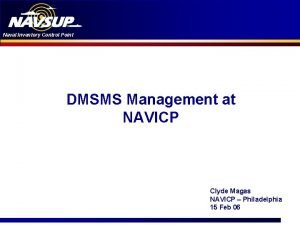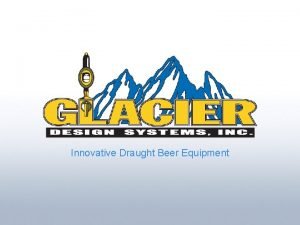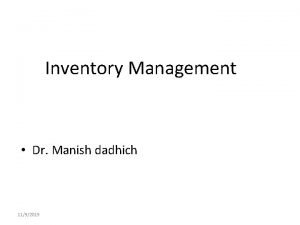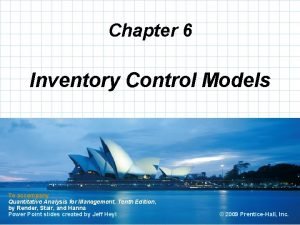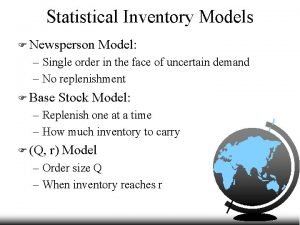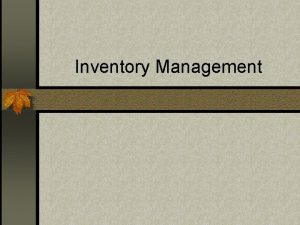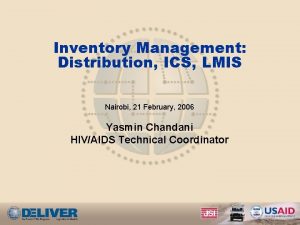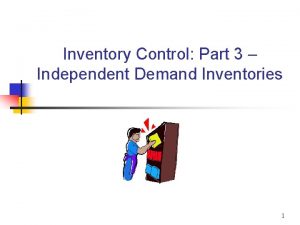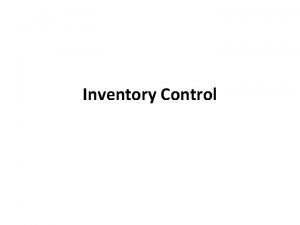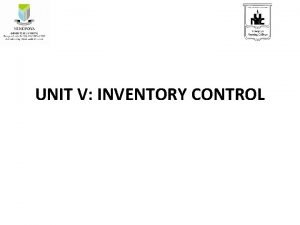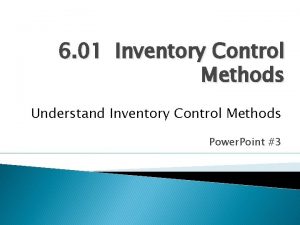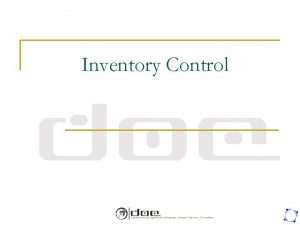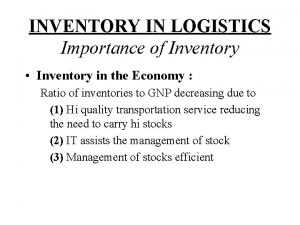Smooth Priorities for MaketoStock Inventory Control Carlos F















- Slides: 15

Smooth Priorities for Make-to-Stock Inventory Control Carlos F. G. Bispo Instituto de Sistemas e Robótica – Instituto Superior Técnico Technical Univ. of Lisbon - Portugal Carlos Bispo Multi-echelon Inventory Conference, June 2001

Outline Ø Problem setting Ø Control policy class Ø Previous work Ø Framework Ø Capacity management Ø Main results and limitations Ø Smooth priorities Ø Results Ø Conclusions Carlos Bispo Multi-echelon Inventory Conference, June 2001 2

Problem Setting - I Ø Multiple Capacitated Machines Ø Each machine has a finite capacity; Ø M machines with Cm, for m = 1, …, M. Ø Multiple Products Ø Each product is characterized by an external stochastic demand; Ø P products with E[dp] and cvp, for p = 1, …, P. Ø Jumbled and re-entrant flow Ø Each product may have different paths through the system; Ø There can be more than a visit to each machine. Carlos Bispo Multi-echelon Inventory Conference, June 2001 3

Problem Setting - II Ø Periodic Review Ø In+1 = In + Pn - (Pn)- Ø Performance Measures Ø Operational Cost based t Holding cost rates for inventory along the line and end product when positive t Backlog cost rates for end product inventory when negative Ø Service Level based t Type-1 Service: percent of demand served directly from the shelf Ø Decisions & Problem t What are the production amounts at any instant for all products? t Minimize the operational costs and/or satisfy service level constraints Carlos Bispo Multi-echelon Inventory Conference, June 2001 4

Control Policy Class - I Ø The system state can be also described by the echelon inventories. Ø En = In + (En)Ø Defined for each product at each buffer. Ø Define an Echelon Base Stock for each echelon inventory. Ø zkmp for all k, m, p Ø k indexes the visit number, m indexes the machine, p indexes the product. Ø Produce the difference between the EBS and the actual echelon inventory. Ø fn, 0 = z - En Carlos Bispo Multi-echelon Inventory Conference, June 2001 5

Control Policy Class - II Ø Bound by feeding inventory Ø fn = min{fn, 0 , (In)+}. Ø Production decisions are functions of fn. Ø Ideally, Pn should equal fn. Ø However, there are capacity bounds. Ø How are we to determine the production decisions when several products compete for a bounded resource? Ø E. g. , how is capacity shared/allocated? Carlos Bispo Multi-echelon Inventory Conference, June 2001 6

Previous work - Framework Ø Single product flow line Ø Glasserman & Tayur (1994, 1995) t Infinitesimal Perturbation Analysis (IPA) to compute optimal echelon base stock levels t Necessary stability condition shown to be sufficient Ø Multiple product re-entrant flow line Ø Bispo & Tayur (2001) t Need to address how capacity is shared both from a static and dynamic point of view t IPA to compute the optimal echelon base stock levels t Necessary stability condition show to be sufficient, even in the presence of random yield and jumbled flows. t Some technical problems with IPA Carlos Bispo Multi-echelon Inventory Conference, June 2001 7

Previous work - Capacity management Ø Static management Ø Divide each Cm into K*P slots, Ckmp - No Sharing; Ø Divide each Cm into K slots, Ckm - Partial Sharing; Ø No static capacity split - Total Sharing. Ø Dynamic management Ø Linear Scaling Rule - Pn = fn * min{1, Ckm/Sp . fn}; Ø Priority Rule; Ø Equalize Shortfall Rule; Ø Other? . . . Carlos Bispo Multi-echelon Inventory Conference, June 2001 8

Previous work - Main results Ø LSR and ESR are close in performance for Partial Sharing, Sharing and beat PR for a wide variety of parameters. Ø However, there are cases where PR beats both (related to average demand, variance coefficient, and backlog costs). Ø LSR degrades its performance for Total Sharing Ø Other than that ESR is usually the best, unless. . . PR. Ø Some dominance results to determine what is the adequate priority list. Ø Lowest average demand, lowest variance coefficient, highest backlog cost should have higher priority Ø The best costs are always achieved under the Total Sharing. Carlos Bispo Multi-echelon Inventory Conference, June 2001 9

Previous work – main limitations Ø When the weights converting units of products into units of capacity, , are not uniform and the system is re-entrant Ø PR does not generate smooth decisions for Total Sharing. t IPA not applicable!!! Ø ESR does not generate smooth decisions for Total Sharing. t IPA not applicable!!! Ø LSR generates smooth decisions but its performance is not the best. Ø How to determine the adequate priority list in the absence of clear cut dominance criteria? Ø Still a combinatorial problem. . . Carlos Bispo Multi-echelon Inventory Conference, June 2001 10

Smooth priorities Ø Key motivation Ø IPA is valid to LSR Ø What changes to introduce in the LSR, keeping it smooth, that will incorporate the concept of priority and will improve its performance? Ø One answer Ø Ø Ø Two phase LSR P 1 n= . fn * min{1, Ckm/Sp . . fn}; P 2 n= (1 - ). fn * min{1, (Ckm-Sp. P 1 n)/Sp . (1 - ). fn}; Pn = P 1 n + P 2 n The new set of parameters, , will determine the adequate priority/degree of importance of each product. Carlos Bispo Multi-echelon Inventory Conference, June 2001 11

Results - I Ø Some preliminary tests Ø One single machine producing two products for which we know what is the best priority order. t Priority to product 1. t Load is 80%. Ø If the best priority order is the best way of controlling such a system then we would expect 1 = 1 and 2 = 0. Ø Also, with such a small scale problem we can have a glance at how does the cost evolve as a function of the priority weights. t Is it convex, smooth, etc. ? Carlos Bispo Multi-echelon Inventory Conference, June 2001 12

Results - II Optimal cost as a function of the priority weights 1= 0 2= 0 cost = 348. 18 1= 0 2= 1 cost = 462. 95 a 1= 1 a 2= 0 cost = 340. 62 1= 1 2= 1 cost = 348. 18 a 1=0. 4 a 2= 0 cost = 330. 30 The optimal priority weights are 1 = 0. 414 and 2 = 0!!! Carlos Bispo Multi-echelon Inventory Conference, June 2001 13

Results - III Ø Single machine, producing three different products Ø Ø Ø E[d 1] = 8, cv 1 = ¼, b 1 = 100 E[d 2] = 12, cv 2 = ½, b 2 = 40 E[d 3] = 20, cv 3 = 1, b 3 = 20 hi = 10, for i = 1, 2, 3 1 = 2 = 3 = 1 Ø From earlier studies we know that product 1 should have higher priority, then product 2, and then 3. Ø Running the optimization we got Ø 1 = 0. 523, 2 = 0. 363, 3 = 0. 006 Carlos Bispo Multi-echelon Inventory Conference, June 2001 14

Conclusions Ø With the two phase LSR we get a way of estimating the relative importance of each product in a continuous space. t Each [0, 1]. Ø No longer a combinatorial problem. Ø Given that each phase is still an LSR, IPA is valid. Ø The mixed problem has been converted into a non linear program where all variables are real: echelon base stock and priority weights. Ø If all are equal to 1 or to 0, then we get the original LSR. Carlos Bispo Multi-echelon Inventory Conference, June 2001 15
 Smart goals for inventory control
Smart goals for inventory control Sde classification
Sde classification Inventory control definition
Inventory control definition Dmsms management plan
Dmsms management plan Draft beer inventory control
Draft beer inventory control Inventory in ppc
Inventory in ppc Importance of inventory control
Importance of inventory control Inventory control model
Inventory control model Eyeball system inventory control
Eyeball system inventory control Statistical inventory control
Statistical inventory control Inventory management objectives
Inventory management objectives Synthes mini frag inventory control
Synthes mini frag inventory control Production planning inventory control
Production planning inventory control Introduction to inventory management
Introduction to inventory management Ics inventory control system
Ics inventory control system What are the 4 types of inventory?
What are the 4 types of inventory?



